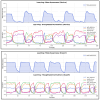Thoughtseeds: A Hierarchical and Agentic Framework for Investigating Thought Dynamics in Meditative States
- PMID: 40422414
- PMCID: PMC12110063
- DOI: 10.3390/e27050459
Thoughtseeds: A Hierarchical and Agentic Framework for Investigating Thought Dynamics in Meditative States
Abstract
The Thoughtseeds Framework introduces a novel computational approach to modeling thought dynamics in meditative states, conceptualizing thoughtseeds as dynamic attentional agents that integrate information. This hierarchical model, structured as nested Markov blankets, comprises three interconnected levels: (i) knowledge domains as information repositories, (ii) the Thoughtseed Network where thoughtseeds compete, and (iii) meta-cognition regulating awareness. It simulates focused-attention Vipassana meditation via rule-based training informed by empirical neuroscience research on attentional stability and neural dynamics. Four states-breath_control, mind_wandering, meta_awareness, and redirect_breath-emerge organically from thoughtseed interactions, demonstrating self-organizing dynamics. Results indicate that experts sustain control dominance to reinforce focused attention, while novices exhibit frequent, prolonged mind_wandering episodes, reflecting beginner instability. Integrating Global Workspace Theory and the Intrinsic Ignition Framework, the model elucidates how thoughtseeds shape a unitary meditative experience through meta-awareness, balancing epistemic and pragmatic affordances via active inference. Synthesizing computational modeling with phenomenological insights, it provides an embodied perspective on cognitive state emergence and transitions, offering testable predictions about meditation skill development. The framework yields insights into attention regulation, meta-cognitive awareness, and meditation state emergence, establishing a versatile foundation for future research into diverse meditation practices (e.g., Open Monitoring, Non-Dual Awareness), cognitive development across the lifespan, and clinical applications in mindfulness-based interventions for attention disorders, advancing our understanding of the nature of mind and thought.
Keywords: Markov blanket; Vipassana; active inference; content of consciousness; embodied cognition; global workspace; meditation; meta-cognition; thoughtseed.
Conflict of interest statement
The authors declare no conflicts of interest.
Figures









References
-
- Varela F.J., Thompson E., Rosch E. The Embodied Mind, Revised Edition: Cognitive Science and Human Experience. MIT Press; Cambridge, MA, USA: 2017.
-
- Noë A. Action in Perception. MIT Press; Cambridge, MA, USA: 2004.
-
- Futuyma D.J. Evolutionary Biology. Trends Cogn. Sci. 2017;21:500–501.
-
- Baldwin J.M. A New Factor in Evolution. Am. Nat. 1896;30:441–451. doi: 10.1086/276408. - DOI
-
- Darwin C. On the Origin of Species. John Murray; London, UK: 1859.
Grants and funding
LinkOut - more resources
Full Text Sources

